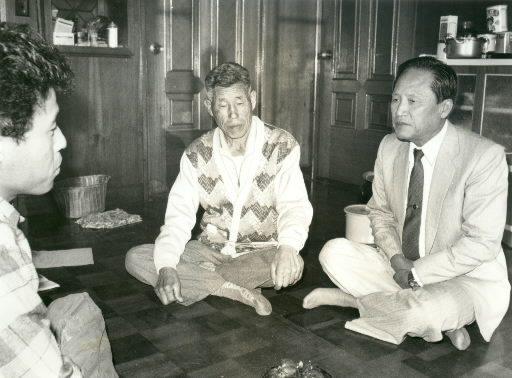6. Learning from an A-bomb Survivor
Feb. 27, 2013
Chapter 4: India, Malaysia, Korea
Part 3: South Korea’s Poisonous Emissions
Part 3: South Korea’s Poisonous Emissions
On August 6, 1945, Koak Ki-Hoon was a cadet in the Japanese Imperial Army stationed in Hiroshima. After the war he became a founding member of the Korean A-Bomb Casualties Association, and is now living in Seoul, where he has just retired from his position as a high school principal after forty years of teaching. Koak is still an avid reader of Japanese literature, and the walls of his study are lined with literary magazines and works by well-known authors.
As one of those who has experienced radiation exposure, Koak is deeply interested in the media debate about nuclear power. Irritated by the manner in which the experiences of Korean A-bomb survivors were being ignored by those involved in the debate over radioactive contamination, he was only too happy to act as our interpreter during our stay in South Korea. "I believe I'll be able to use my experiences to help," he told us.
Koak drove us around the areas on which media attention was focused, in his beloved new car, recently bought with some of his retirement money. When we visited Kim Ik-Sung and Kim Dong-Pil, the day laborers who had sparked the nuclear debate, they turned to Koak and asked whether he thought they should have any more children. Koak switched from interpreter to adviser and reassured the men that he had three sons and two daughters, saying that, although he could understand their concern, the important thing was for them to look ahead to the future, not dwell on the past.
Meeting the family of Pang Yoon-Dong, who died a painful death from stomach cancer, Koak was reminded of his own hardships and his endless efforts to obtain recognition and compensation from the Japanese government. To this day the Korean nationals who were in Hiroshima and Nagasaki at the time of the bombing have received neither apologies nor compensation from their former colonial masters.
"I suppose it can't be helped," he said bitterly, "after all, how can you fight a whole country?"
The ex-principal did not reserve his criticism for Japan, and commented that he thought the antinuclear movement seemed unaware of some basic facts about radiation. To their claims that radiation damage may be passed on in the genes he retorted, "On what basis can you make that statement?" Neither did the power corporation escape the lash of his tongue. Every time Koak heard the statement that employee radiation levels were well below the danger level, he commented that surely it would be better to make sure that employees were exposed to no radiation at all. As a pipokja, or A-bomb victim, himself, Koak has no time for those who argue without possessing more than a superficial knowledge of what they are talking about, nor for those who try to escape their responsibilities. The two sides of the media debate on nuclear power refuse to budge from their respective standpoints, with the result that the victims and their families have been left stranded in the middle not knowing who to believe.
Some fifteen years ago, Koak published a book in Japanese, Korean Radiation Victims, in which he harshly criticized Japan for ignoring its responsibilities toward the Korean victims of the A-bomb. That fight continues today. Koak now feels it is also his mission to contribute what he can to this latest nuclear debate:
"Being a victim of the Hiroshima A-bomb, I believe I am more qualified than anyone else to speak about this issue, and I feel it's my duty to do so. We can help prevent the possibility of radiation claiming future victims and enable a greater number of people to understand the victim's point of view. I believe the time has come for us to play a more active role in this debate." After clocking up approximately eight hundred miles traveling to and from nuclear power plants and the settlements near them, these were Koak's parting words.








